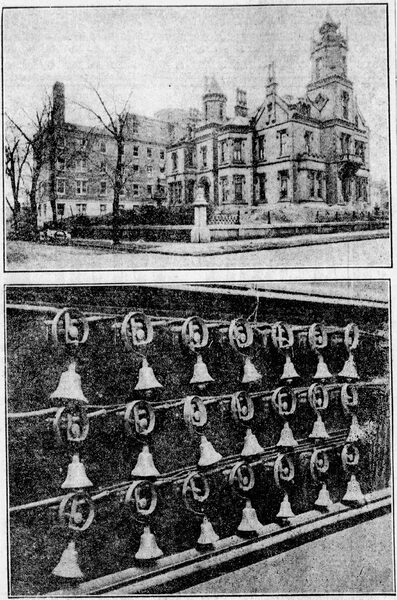[Newspaper]
Publication: The Kentucky Post
Covington, KY, United States
vol. 4, no. 34, p. 1, col. 3-5
Historic Mansion to Pass
| |||
| HERE IS THE AMOS SHINKLE MANSION AND ITS ELABORATE SERVANT BELL SYSTEM. |
* * *
The clatter of pickaxes, sledges and wrecking bars will sound the knell this week of one of the historic houses of Covington, the Amos Shinkle homestead on E. Second-st. near the Licking River.
Within a fortnight there will be little of the magnificently furnished mansion that was the pride and the show place of Covington a half century ago. In its place will be the front and the lawn of a new show place of the city, the new Booth Memorial Hospital.
The Salvation Army, which conducts Booth Hospital, has had possession of the Shinkle home for the past 12 years, thereby fulfilling a premonition, or mere correctly perhaps, a prophecy of Amos Shinkle.
When the builder was asked why he wished to erect such a huge structure, containing 32 rooms, his answer was:
"Some day it will be a home for the friendless."
Tho he did not live to see it, the house on which he had expended a fortune became a home for unfortunate girls in 1912, just 43 years after its completion in 1869, thus realizing his prophecy.
One of the legends which has grown up about the home is that the prince of Wales, later to become King Edward of England, had been the guest of honor at a reception there during his American tour. Tho this tale is widely accepted, it has been found difficult to confirm.
Another visitor, tho, about whom there is no doubt, was President U. S. Grant, who came to visit his father, Major John Grant, a resident and former postmaster of Covington.
One Covingtonian, then "a little girl in pigtails," who remembers the president's visit well, is Mrs. F. A. Rothier, E. Second-st.
"It was quite a thrill for a little girl to meet the president," she says. "The home was decorated with flags and flowers and a great crowd had gathered in the street. My father, L. E. Baker, was mayor of Covington and he made the welcoming address to the president from the balcony."
One of the most interesting features of the house is a board containing a number of bells, mounted high on the wall of the hallway. Each room had a wire leading to a different bell, and the tingling of the bells summoned servants.
Another point about the house that attracts attention is a three-foot brick tunnel leading from the cellar toward the Ohio River. The purpose of this tunnel is not exactly known. It may have been used as a secret passageway to the river or, what is more likely, was used as a sewer. Water was pumped to a tank in the top floor of the house from several large cisterns in the rear and the house was well supplied with bathrooms.
Magnificient [sic] Magnificent carved woodwork, beautiful mirrors and statuary and patterned hardwoood floors of varicolored woods adorn the interior. Considerable of the furniture and other fixtures were given to the Salvation Army along with the house by the Shinkle heirs in 1912.
A cut-glass chandelier that dates back to the "old Crinoline days" has been remade for electric lighting and now hangs in the Shinkle reception room of the new hospital.
